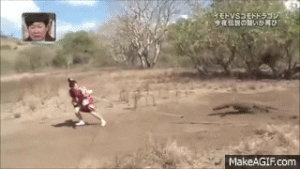Physical Description
The Komodo dragon, scientifically known as Varanus Komodoensis, is the largest land living reptile and relative to the monitor lizard family.The Komodo, most notable for its size, can reach maturity at a hefty 200 lbs and a length of an astonishing 8ft long, dwarfing the measurements of its fellow monitor lizard species. It’s features are also notable, having large limbs, a flat, squared head, and its lengthy tail, typically the length of its entire body. It has overlapping, thick, sand colored scales which come together to cover the entire 8ft frame in a formidable hide for defense. It compliments this defense with 60 serrated teeth, used both for tearing flesh, and as a means of hunting for prey, which will be explained further into the article. As member of the monitor lizard genus and closely related to snakes, Dragons unhinge their jaw in order to consume hunk of meat rather than chewing. Their large forelimbs are used both as a means for burrowing and mobility, some specimens being scene to run up to 12 miles per hour.
Behavior and Diet
Komodo’s are some of the most territorial animals on the planet, being compared with lions in terms of ferocity and aggression. As a part of the lizard family, Komodo’s love the sun, along with the dry climate, seen in their population map, located on the arid island of Komodo along the archipelago of Indonesia. During the night in order to preserve body heat, Komodo dragons utilize their large and powerful forearms and claws in order to dig deep burrows. These huge lizards are mostly solitary, only recorded as resorting to social behaviors when pursuing prey or during the mating season. If not previously eluded to, these huge creatures are the apex predator on their secluded island, and their method to hunting prey is truly meticulous and horrible (for the prey that is). Their secret lies in the saliva, filled with hundreds of different types of seriously dangerous bacteria, similar to venom. Sliding back from the loose line of gums, are it’s hook like teeth and sacs filled with this toxic saliva, which the lizard uses to attack. They stalk their prey, sneaking up to an unsuspecting animal and striking it with just a bite of its toxic compounds. They wait beside the animal for days, waiting until the bacteria completely immobilizes the animal for the Komodos to pounce. Their diet, obviously from the previous statement, is comprised entirely of other animals.

Interactions with Outside World/ Conservation
Because of the danger these animals possess, the island they reside is uninhabited by humans. The location of the dragons, their interactions with humans, and their solitary behaviors contribute much to the recent conservational concerns. The lizard has had problems with surrounding islands, being on the ring of fire, experiencing constant Volcanic activity leading to a decline in numbers. Humans aren’t blameless, having a hand in their decline in part due to poaching and with an increase in Indonesian tourism. On the hopeful side, poaching has been criminalized against this creature, enforcing legislation with involvement of Indonesian national guard under the hope of stopping poaching of exotic animals altogether.

